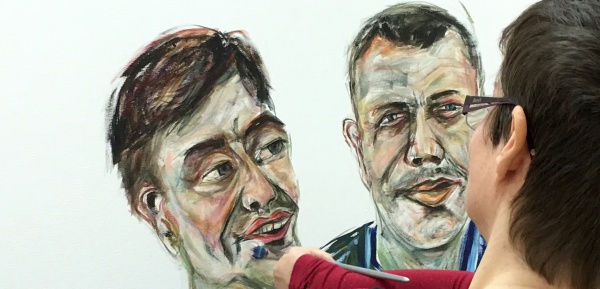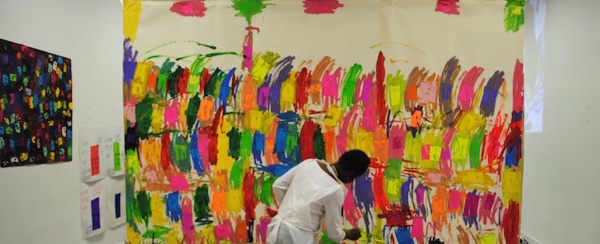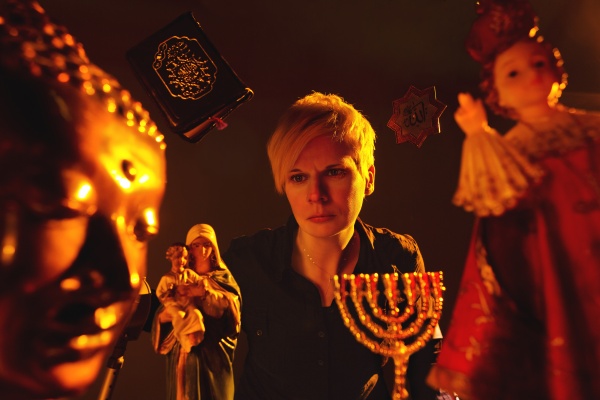Colin Hambrook, Editor of Disability Arts Online curates a list of artists and companies who in the process of developing their work, have shifted a few definitions of the possibilities and challenges that art can present.
I’ve had the privilege of working at the hub of the disability arts sector since the mid-1990s. It’s been an incredible journey, watching so many artists emerge through disability arts to make work and achieve acclaim on a national and international stage.

Tanya Raabe-Webber doing a live-sitting portrait Image © Project Ability
I founded Disability Arts Online in the early 2000s as a space for emerging artists to have a voice through our blogs; to become immersed in the conversations that underpin disability culture and to critique the art through our interviews, reviews and opinion pieces. My passion has always been about giving credibility to the unique approach to creativity that disabled artists demonstrate and advocating an understanding of the place that disability arts deserves within the canon of art history.
The most enduring art, the art that has affected how we live and think has always been made by artists living on the margins of society… and it’s my sincere belief that a large number of the artists who have become household names would, if they were alive today, be aligned with disability arts.
Disability Arts International is more pragmatic in its approach in giving a platform to promote current tour-ready work for an international audience.
There are many current artists who are influencing the way we think about art. Tanya Raabe-Webber’s Portraits Untold project, for example, is redefining portrait painting for the 21st century. Tanya invited David Hoyle, John Akomfrah, Evelyn Glennie and Neil Baldwin – all prominent figures from the world of arts and culture – and put them in front of an audience to take part in a live sitting. Using live streaming and social media as a vehicle to invite creative responses, which over the course of the day’s sitting are added to the artwork, Tanya is democratising drawing – as a language – in a way that no artist has done before. Two Disability Arts Online bloggers posted their portraits untold – both Deborah Caulfield and Jane McCormick.

ActionSpace artists create large scale temporary installations Image © Action Space
ActionSpace have been working with artists with learning difficulties for several decades with the intent of supporting a means to get the work seen and appreciated on an equal footing with work made by artists within the mainstream. It’s no easy task, but in collaboration with Outside In and HOUSE the organisation supported Thompson Hall to produce a major commission within the Brighton Festival last May, showing his work in tandem with a piece by Gillian Wearing shown in the city. Hall produced ‘Home Away from Home’ a series of paintings that presented his ideas on the theme of ‘home’ from a psychological perspective. Reviewed on Disability Arts Online, his paintings reflected on themes of outside and inside that have been concerns of the visual arts since the beginnings of abstraction.
sean burn is an artist immersed in a wide variety of art-forms, whose work continues to defy pigeon-holing crossing visual, performance, literary and digital art forms with ease and uncomforting elegance. An abiding concern within his work is the disconnect between hierarchy and human rights. Often playful to the point of frivolous, as in his series of work that ‘may contain nuts,’ he is also capable of writing and producing arresting theatre that cuts to the quick as with his epic love story told across four centuries ‘Collector of Tears’, which received the accolade of Best North East new play of 2014 by the British Theatre Guide.
Like sean burn, Julie McNamara is another artist whose work I’ve followed on a longstanding basis, who continually seeks to redefine our language around madness. Is it us or the world we live in, that drives us mad? With her theatre company, Vital Xposure her work is always delivered with a truth and honesty that comes from the heart. Whether that’s exploring the humour and the pathos of the impact of dementia on family relations as in Let Me Stay, or telling the story of the silencing of a young female journalist who sought to step into a soldier’s shoes in 1915 as in The Disappearance of Dorothy Lawrence.

Claire Cunningham, Guide Gods. Photograph: Eoin Carey
The biggest strength and weakness of Disability Arts is the fact that it covers all art forms making it difficult to define, but equally opening up boundaries, mixing and merging creative approaches. Claire Cunningham works within what is broadly defined as contemporary dance, but continually pushes at the boundaries making it impossible to predict what kind of a show she’ll devise next.
Guide Gods was an invitation to attend a tea party and to hear people’s stories of faith and of living within a community. In contrast, Give Me a Reason to Live was a bleak performance in which she took the audience on a journey to the dark ages. Her recent Unlimited commission The Way You Look (at me) Tonight with choreographer Jess Curtis was an indulgent step into the philosophical reflections of dance-makers on what dance is.

